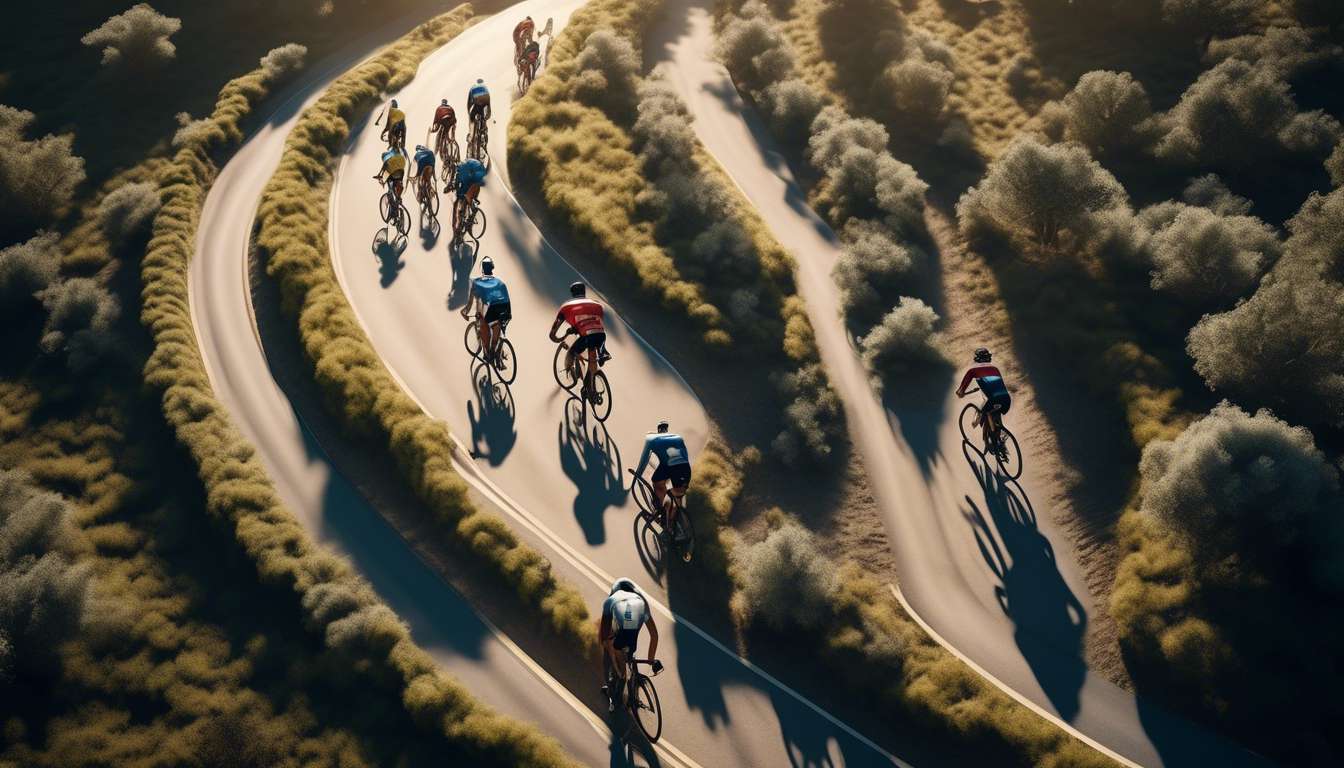As devoted followers of professional cycling, we have often found ourselves captivated by the intricate tactics that unfold during each race. Cycling is not merely about who pedals the fastest; it is a complex sport where strategy plays a pivotal role.
Together, we delve into the world of professional cycling to uncover the layers of tactics that can decide the outcome of a race. From team dynamics to the careful management of energy and even the psychological battles between riders, each element contributes to the thrilling unpredictability that defines the sport.
Key elements in cycling tactics include:
- Team Dynamics
- Energy Management
- Psychological Battles
Cyclists and their teams meticulously plan and execute strategies, adapting to the ever-changing conditions of the race. This involves:
- Analyzing competitors’ strengths and weaknesses.
- Deciding when to attack or conserve energy.
- Coordinating team efforts to support a lead rider.
As we embark on this journey, we invite you to join us in discovering what makes professional cycling not just a physical endeavor, but a chess match on wheels where every move can be the difference between victory and defeat.
Team Roles and Strategies
In professional cycling, each team member has a specific role that contributes to the overall strategy and success of the team. Every pedal stroke is part of a bigger picture where teamwork transforms the rugged terrain into a stage where strategy comes alive. It’s not just about individual strength; it’s about how we unite, using our unique skills to navigate the challenges ahead.
Our team includes several key roles:
- Climbers: Lead us up steep inclines, making the toughest terrains seem conquerable.
- Sprinters: Rely on explosive power to ensure we’re in prime position for those crucial race-ending moments.
- Domestiques: The unsung heroes who protect and support, sacrificing personal glory for collective triumph.
Together, our strategy is woven through communication and trust. We anticipate the terrain, adapt to its demands, and execute tactics that only teamwork can bring to life. We belong to something greater than ourselves.
Race Course Dynamics
Every race course tests our strategic acumen and adaptability, challenging us to harness the unique features of each terrain to our advantage. We find unity in our team as we tackle these diverse landscapes, from steep mountain climbs to flat, fast sprints. Each course demands specific strategies, and our teamwork becomes our strongest asset.
In mountainous terrains, we might need to:
- Shield our climbers
- Conserve energy for critical ascents
In contrast, on flat terrains, we often:
- Form aerodynamic lines
- Maximize speed and efficiency through coordinated drafting
Our strategy isn’t just about individual strength but about orchestrating a collective effort. We analyze each course’s terrain to decide:
- When to push the pace
- When to conserve energy
The unpredictable nature of race courses requires us to communicate effectively, ensuring we’re always prepared to adapt. It’s our shared commitment and understanding that bind us, making us not just a team, but a cohesive force, ready to conquer any challenge together.
Sprinting Tactics
In the electrifying final meters of a race, we unleash our well-honed sprinting tactics to outpace our rivals. It’s not just about raw speed; it’s about precision and teamwork. We work in harmony, each team member playing a crucial role.
Our Sprint Strategy:
- Lead-out riders set a blistering pace.
- Shielding the sprinter from wind resistance.
- Conserving the sprinter’s energy for the decisive moment.
As we approach the finish, strategy becomes paramount. We analyze the terrain, knowing when to accelerate or stay steady.
Terrain Considerations:
- A slight incline demands a different approach than a flat sprint.
- Constant communication to adjust strategy dynamically.
Trust binds us; we know we’re stronger together. In these moments, we connect with something larger than ourselves—a shared pursuit of victory. Together, we transform the chaotic final moments into a symphony of speed and precision, aiming for the win.
Climbing Strategies
In the challenging ascent of a race, we rely on meticulous pacing and efficient energy management to conquer the climb. Our success hinges on teamwork, as we support each other through grueling gradients and unpredictable terrain.
We form a cohesive unit, each of us playing a vital role, whether it’s:
- Setting the pace
- Protecting our leader
- Responding to rival attacks
Our strategy is fluid, adapting to the terrain’s demands.
- On steep sections, we may employ a high-cadence rhythm to minimize lactic acid build-up.
- Longer, gentler slopes might require a steady, sustained effort.
We communicate constantly, ensuring:
- Everyone knows their role
- Any tactical shifts necessary to maintain momentum or launch a decisive move
Together, we analyze the climb’s characteristics, planning when to conserve energy and when to push hard. This shared focus and mutual support affirm our bond, as we rise to the challenge, united by our pursuit of victory on the mountain.
Time Trial Techniques
In a time trial, we focus on optimizing aerodynamics and maintaining a consistent power output to shave off precious seconds. Together, we embrace the challenge, knowing that every detail counts.
Our strategy starts with teamwork—each member plays a crucial role in preparation. We share insights on the terrain, ensuring we’re all ready for the unique demands it presents.
Key considerations include:
- Is there a steep climb?
- A sharp descent?
We need to be prepared for anything.
Our aerodynamic position is key, and we work with our team to perfect it. We streamline our gear and refine our posture because every watt saved can make the difference.
On race day, it’s about executing our strategy flawlessly. We monitor our power output, keeping it steady, because surging too early can cost us later.
Being part of this team means trusting each other and our plan. Together, our collective effort transforms individual strength into a unified force on the road.
Breakaway Planning
In a breakaway, we seize the opportunity to escape the peloton, leveraging precise timing and collaboration to gain a competitive edge.
Our teamwork becomes crucial as we work together to navigate the terrain effectively. By analyzing the course, we identify the perfect moment to make our move, often choosing sections where the terrain favors our strengths.
- Uphills
- Downhills
- Flat stretches
These can be strategically selected based on our team’s skills and the race dynamics.
Our strategy isn’t just about raw speed; it’s a careful balance of energy conservation and optimal effort.
- We take turns leading the breakaway.
- This allows each rider a chance to recover while maintaining a steady pace.
Communication is key, ensuring we’re all aligned and responsive to any changes in the race scenario.
Together, we create a shared sense of purpose, knowing that our unity can make the difference between success and being reeled back in by the peloton.
Peloton Management
Effectively managing the peloton requires us to anticipate its movements and adapt our tactics to maintain control and position. As a cohesive unit, we rely on teamwork to navigate the complexities of the race.
Our strategy is rooted in understanding the dynamics of the peloton, which can shift rapidly with changes in terrain and the ambitions of rival teams. Together, we must communicate seamlessly, ensuring each member knows their role and when to execute it.
Our shared goals are:
- Maintain a strong position within the peloton to respond swiftly to any attacks or breakaways.
- Adjust our approach on varied terrain:
- Conserve energy on flats
- Push harder on climbs
- Protect our lead riders, positioning them optimally for the sprint finish.
By working in unison, we create a sense of belonging within the team, knowing that our collective efforts drive us towards victory.
Weather Conditions Impact
Weather Conditions and Race Dynamics
Weather conditions dramatically alter race dynamics, demanding that we swiftly adapt our tactics to maintain our competitive edge. When rain slicks the roads or wind gusts across open terrain, our strategy requires seamless coordination.
Teamwork and Strategy Adjustments
- Teamwork becomes crucial as we form echelons to shield each other from the wind, ensuring we conserve energy for crucial moments.
- Trust in each other binds us, making us feel part of something greater.
- Navigating wet or icy terrain demands a careful balance of aggression and caution.
Tactical Coordination
- We rely on each other’s strengths, creating a strategy that maximizes our collective abilities.
- Our lead riders gauge the pace, while those behind provide feedback on the terrain’s grip.
- Together, we adjust our tactics, maintaining our momentum while avoiding unnecessary risks.
Adapting to Extreme Temperatures
In oppressive heat or biting cold, our unity is tested, but it’s our shared strategy and teamwork that help us persevere. Adapting to weather isn’t just a challenge—it’s where we thrive.
How do professional cyclists maintain their energy levels throughout a long race?
To keep our energy levels up during a long race, we focus on proper nutrition and hydration.
Fueling our bodies with carbohydrates and electrolytes before and during the race is crucial. This ensures that we have a steady supply of energy and maintain our electrolyte balance.
We also pace ourselves by:
- Conserving energy when needed
- Pushing through when it counts
Our support team plays a key role by:
- Providing us with snacks
- Supplying drinks along the way
By staying disciplined and listening to our bodies, we can perform at our best.
What technological advancements have most influenced modern professional cycling?
Technology has revolutionized modern professional cycling.
From aerodynamic bikes to advanced data analytics, these advancements have reshaped the sport. Key innovations include:
- Carbon fiber frames
- Electronic shifting systems
- Power meters
Additional tools that provide invaluable insights are:
- GPS navigation tools
- Real-time performance tracking
These innovations have not only enhanced performance but also transformed the way we strategize and compete.
Embracing these advancements is crucial for:
- Staying ahead of the competition
- Achieving success in the sport
How do cyclists communicate with their team during a race?
During a race, cyclists communicate with their team through a variety of methods.
Communication Methods:
- Hand Signals: Used to indicate immediate actions or changes in direction.
- Verbal Cues: Short and direct instructions or alerts shared among team members.
- Modern Technology: Radios are used to stay connected over longer distances or when visual contact is not possible.
These communication tactics help in:
- Strategizing: Developing and adjusting race strategies in real-time.
- Coordinating Attacks: Timing attacks or sprints to maximize effectiveness.
- Providing Support: Offering assistance to teammates, whether for pace-setting or mechanical issues.
Clear and effective communication is crucial to ensure the team works together seamlessly as a cohesive unit on the road.
Conclusion
In conclusion, professional cycling is deeply tactical due to the intricate interplay of various elements.
Key aspects of cycling strategy include:
- Team roles: Understanding and executing specific responsibilities within the team.
- Race course dynamics: Adapting strategies based on the unique characteristics of each course.
- Sprinting tactics: Timing and positioning to achieve maximum speed in key moments.
- Climbing strategies: Efficient energy use and pacing on challenging ascents.
- Time trial techniques: Maintaining speed and aerodynamics over individual efforts.
- Breakaway planning: Deciding when to attempt escapes from the main group.
- Peloton management: Navigating the main group effectively to conserve energy.
- Weather conditions: Adjusting approaches based on environmental factors.
Success in competitive cycling requires:
- Constant analysis of the race situation.
- Adaptation of tactics to outsmart opponents.
- Precise execution of strategies to navigate the challenges of the road.
Every aspect of the sport demands strategic thinking and precise execution to achieve victory.




